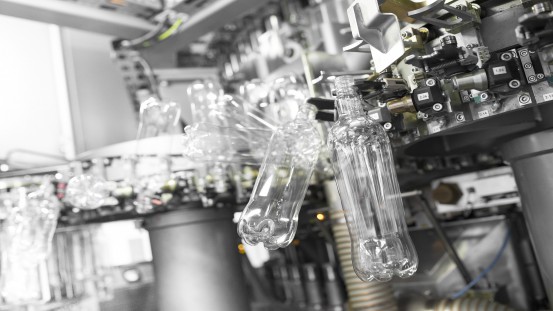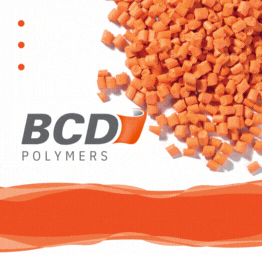When Bernd-Thomas Kempa, who has been in charge of Sales & Service since 2012 and is now head of Plasmax Barrier Technology Global Account Management, and Dr. Joachim Konrad, who has been responsible for engineering as director of Plasmax Barrier Technology since 2014 and is now head of the Large Machine Product Division at KHS, talk about the history of FreshSafe PET®, frequent mention is made of the words “persistence”, “conviction” and “trust”. Together with their team, in a manner of speaking the two are the trailblazers behind the transformation of KHS Plasmax barrier coating technology from a niche product to a market-proven, tried-and-tested packaging system for the food and beverage industries.
The story of FreshSafe PET®, also known as Plasmax, began in the 2000s. This was when Schott AG and SIG Corpoplast launched a joint venture for the plasma coating of PET bottles to cater for changing packaging preferences in the industry. In doing so they pooled the expertise of an international manufacturer of glass and glass ceramics with that of a packaging producer and engineering company for the processing of plastics. Schott AG’s portfolio also included a glass coating which was applied to the insides of glass containers as a supplemental layer. “This protected highly sensitive pharmaceutical products from substance migration,” explains Kempa.
Challenges for customers and KHS
During the course of the joint venture a prototype of the first generation of Plasmax machines was developed and in 2002 the first Plasmax machine was tested in Switzerland with an output of 10,000 bottles per hour. Plasmax was also granted regulatory approval for use in the food industry in Europe, the USA and Japan. Two Plasmax 12D machines were then shipped to Japan for the protective packaging of sensitive, top-quality products. In 2006 Eckes-Granini was the first European fruit juice company to go to market using this technology. “The constant aim of development was and still is to integrate just one machine which satisfies bottling plant conditions and meets customer expectations,” says Kempa. System availability in particular had to be at an established level typical of the industry from the very start. “Looking at our success now and at the growing demand for this machine, we can say that it was worth it. We still nurture a certain start-up mentality in the team, though,” adds Konrad.
“With the dissolution of the joint venture and the takeover of Plasmax technology by KHS in 2008 we were given plenty of backing. However, as part of a global enterprise our small team was also required to prove that this technology could be just as sustainable in the beverage industry environment,” Kempa states. “Without the support of KHS and our parent company Salzgitter AG it wouldn’t have been possible to successfully transform this technology and break even. Success would have been equally lacking had we not had the special way of working together we still foster, with plenty of team spirit and great willingness shown by all members of the team,” he adds.
This support and sense of trust also increased among the company’s customers: alongside other machine sales in 2010 the prototype of the larger second generation of Plasmax coating machines went to Eckes with a capacity of up to 27,500 1.0-liter bottles an hour. In 2014 the company procured the world’s first FreshSafe block for its plant in Fallingbostel, a system blocked with a KHS stretch blow molder which produces a maximum of 32,000 0.75-liter bottles every 60 minutes. “KHS enjoys a trusting partnership with Eckes-Granini which goes back several decades where systems can be implemented to the benefit of both parties. This enabled Eckes to recognize the potential offered by a more sophisticated style of PET packaging very early on, for example, giving them optimum protection for their sensitive beverages,” says Kempa.
Plasmax portfolio continuously expanded
“Eckes-Granini saw the opportunities rather than the possible snags and was open to new developments and processes. We mustn’t forget that to start with this was new territory for all involved,” Konrad explains. Both parties profited from what was learned during the intensive partnership, helping to optimize innovative processes with regard to practical use and come up with totally new solutions. In this way Plasmax has steadily expanded its range of products over the years. The machine manufacturer now supplies not just its standard coating machine and the InnoPET FreshSafe block but also a Plasmax 2Q/4Q for the low-performance range and an InnoPET FreshSafe TriBlock with a stretch blow molder and filler/capper combination which can produce up to 48,000 bottles an hour. “FreshSafe PET® combines perfect product protection with sustainable recyclability. At the same time costs can be cut by saving on PET material. This gives us unbeatable arguments for this style of food and beverage packaging,” smiles Kempa.
The company’s success corroborates this: the interest shown by the beverage industry in FreshSafe PET® and other KHS PET technologies is on the increase because they are sustainable, believes Konrad. In order to perfectly meet the growing demand from the market, in 2016 production capacities at the Hamburg production site were increased. One major global soft drinks producer, among other clients, is now relying on FreshSafe PET® for its bottling operations at its plants in Asia and North America. “Together with this beverage bottler we’ve managed to apply all of the advantages of our Plasmax system. We’ve been able to achieve this positive result because all of the main issues – from preform and bottle design to the customer’s production options – were integrated into our search for the optimum solution. This was the breakthrough for us in the beverage sector,” Konrad exclaims.
Key factor for environmental protection
Several factors play a role when a customer makes his or her decision to buy. With FreshSafe PET® no unwanted substances enter the product from the outside, for instance – and valuable ingredients such as vitamins cannot escape. Thanks to Plasmax barrier technology sensitive and carbonated beverages also keep up to ten times longer than in the conventional PET bottle. This is a key factor, especially for bottlers whose products have to travel long distances. Furthermore, the wafer-thin layer of glass reliably protects sensitive products against loss of freshness and quality, thus making a considerable contribution to the protection of the environment. “The more reliable the product protection, the lower the amount of food wasted,” says Konrad. This barrier technology is also suitable for coating PET bottles made of recyclate (rPET) and for biodegradable containers.
Kempa and Konrad believe that the key factor for environmental protection is not just weight reduction but also the full recyclability of FreshSafe PET®. By avoiding the use of different material components this coating technology enables the PET material to be collected by type and thus containers to be fully recycled. This has been confirmed by a number of independent international experts and trade associations such as the APR[1] and EBPB[2], among others. In the face of the growing demand across the globe for clean recycling systems this is a crucial aspect, claims Kempa. “Customers and the public are increasingly calling for environmentally-friendly packaging systems; a product is only successful when it solves a relevant problem. With FreshSafe PET® we’ve created an environmentally-friendly and cost-efficient system which combines sustainability with the best possible product protection.”
Less use of materials cuts costs
In addition to environmental aspects and the protection of the product economy is also important. By using KHS technology bottles weigh less than those which contain additives, in turn cutting down on the amount of material required and thus saving on costs. Moreover, bottlers can also switch to using less expensive standard PET preforms, again reducing the cost per bottle.
“All of these factors have helped FreshSafe PET® evolve from a mere vision to a popular and sustainable form of packaging,” enthuses Kempa. “And we’re convinced that the success of this product is set to continue for some time yet. We expect that in the future environmentally-friendly packaging will be inextricably linked to our responsibility to further reduce our carbon footprint. KHS is contributing by having less food go to waste as it’s packaged in an optimized type of container.”



